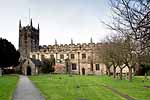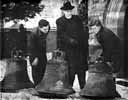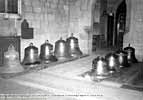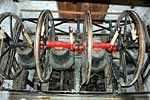 West Bridgford West Bridgford
St Giles
Bells
It has been suggested that, before the present tower was built at the beginning of the sixteenth century, there may have been either a small tower built in the Early English style or otherwise a gable-bell to remind the faithful in their homes or at work in the fields that the mass was being celebrated at the altar.
However, the first documentary evidence of bells is in 1553 when the Commissioners of Church Goods reported that there were ‘three bells of one accorde, hanging in ye steeple of ye same church.’ They were all made locally.
 Fragments of Fragments of
bell inscription |
The treble, or lightest bell, weighed 3¾ cwt and was the work of John Woolley of Nottingham, made sometime between 1524 and 1536. It is thought to have served as the Angelus bell, used in medieval times as a daily call to prayer at sunrise and sunset. It was inscribed Ave Maria: this inscription has been preserved and can be seen on the wall by the south door of the church.
The other two bells came from the founder Richard Mellours, one time mayor of Nottingham. One of these bells, cast reputedly in 1499 (and certainly from around this date), has been preserved inside the church. It weighs 3cwt 3qrs 15lbs, with a diameter of 27.25” and sounds the note D. It bears the inscription, in old English, of Celorum Christe[xtc] placeat tibi rex sonus iste,which has been translated as ‘May Christ, Heaven’s King, be pleased with this Ring’.
The book of the churchwardens’ accounts from 1759 onwards shows that the three bells were being rung regularly during the second half of the eighteenth century. New bell ropes were a common feature of the accounts, averaging out at about one new rope each year. In 1762, a rope for ‘the Great Bell’ cost 1s 7d. Similarly, oil for the bells at 6d was a common purchase.
The accounts also record the maintenance and repair work carried out. At the end of 1773, 2s was paid ‘to William Savage for mending the bell wheel’ and, shortly afterwards, 1s was paid ‘for putting in the bell clapper.’ Similarly, in 1786, John Plowright was paid 6d for ‘mending the bell’.
The belfry also received attention. In 1778, 8d was paid for mending the belfry door and chamber floor. Then, in 1802, a lock and key were bought for 2s 8d and 6d paid for the lock to be fitted to the belfry door.
For many years, there was a payment to the bellringers of 3s 6d for a year’s ringing. This was often augmented by 1s for ringing on Christmas Day, another 1s for New Year, and 1s 6d for 5th November. (The Book of Common Prayer contained a prayer of thanksgiving for deliverance from the gunpowder plot until it was removed in 1858 and the bells would have been rung to mark the anniversary.)
Presumably one of the ancient bells became cracked or otherwise unusable for, in June 1813, the church accounts record that one of the bells was taken down, at a cost of 9s 6d, and for a further 1s transported to Nottingham. Later that year, in November, 7s was paid for ‘the carriage of the new bell from Nottingham &c’ and 5s 6d was paid to ‘Gill Handley for assisting with the new and old bell’. The new bell itself cost £29 9s 0d. It was cast by J and E Smith of Chesterfield and weighed 5 cwt. It bore the inscription:
J. & E. SMITH & CO
CHESTERFIELD
1813
GLORIA DEO |
Over time, the condition of the three bells deteriorated and, in 1933, the parish magazine published an article on weddings, which admitted that ‘our ancient bells are so un-joyous in their music that few brides claim the privilege of a wedding peal’. Indeed, it was said that the bells were so out of tune that they were known to residents as ‘Knick, Knack and Poof’.
A few years later, in 1937, one might have been forgiven for thinking that matters had improved for the magazine reported ‘as part of the Coronation celebrations, it was decided to give West Bridgford a surprise by arranging for a peal of bells to be heard from the church tower. From all that we hear, the surprise was agreeable and pleasant, so much so that we are being urged to make the innovation a permanent thing.’ However, the next paragraph told the full story: ‘Gramophone records of famous bells are played on an instrument under the belfry inside the church; wires are run through the tower to an amplifier, and thence to loudspeakers affixed to the base of the flagpole on the tower. The reproduction is excellent, and the bells can be heard in all parts of the district.’
It seems that this was seen as the way forward, for the article ended by saying ‘it has been suggested that a completely new and modern apparatus be installed as a Coronation gift to the church by the parishioners, and donations (large and small) should be handed in to the clergy or wardens at once. We need the sum of £80 if the peal of bells is to be retained.’
The improvement, however, was short-lived as this reminiscence from the parish magazine in 1954 revealed: ‘Some years ago the writer of this article was crossing Trent Bridge on his way to West Bridgford when he heard the sound of bells and at first could not imagine where the sound came from, but then remembered the apparatus in the Church and the loud speakers on our Church Tower and the mystery was solved. They sounded very well at that distance while the whole thing was new, but how different it all became after two or three years’ wear. The gramophone, the records and those who heard the distorted noise “groaned and travailed in pain together.”’
By the 1940s, the bell installation had become derelict with only one bell safe to use – and that only for tolling. The wooden floors had also decayed. Indeed, when they were eventually taken down they were found to be utterly decayed with dry rot and beetle: the joiner put his foot through it on the first morning.
The bells may well have continued in this condition for many years, if Canon Wilkinson had not been appointed rector in 1940. Among his many other interests, he had long been a keen bellringer, so it was perhaps natural that he should make an effort to get St Giles’ bells ringing again and, if possible, increase the number of bells.
Wartime and other pressing needs caused some delay but, eventually, an open public meeting to discuss the bells was held on Monday, 14th June 1954. The meeting was told that an anonymous donor had promised £500, which others had increased to £700. A Trust Fund for the restoration of Ancient Bells had agreed to provide another £700. Following other promises, that just left another £300 to be found for repairs to the floors and steps and alterations in the tower.
 The bells outside in The bells outside in
early 1955 |
 The bells on display The bells on display
in the church |
A Gift Day was held and a further £249 was raised. A faculty for the work was granted and the three old bells were removed from the tower early in 1955.
As a first step to creating a ring of eight bells, St Giles’ bought the five bells from Perlethorpe in Thoresby Park, as they could no longer be rung there. Two of those were hung as the third and fourth bells of the eight. The other three, together with two of the original three bells from St Giles’ were melted down by the bellfounders, John Taylor and Co. of Loughborough and used to cast six new bells. Before they were hung in the tower, the bells were displayed inside the church, together with the pre-Reformation bell that was preserved.
 The bells in 2013 The bells in 2013 |
The tower is just ten feet square (0.9 m2) so, to fit the bells in, they are hung for full circle ringing with one layer of four bells above another. Even so, the bells had to be quite small and are fitted with Hastings stays which take up less room then the more common use of stays and sliders. The bells are hung in a double iron frame on steel girders.
When the bells were tried, the parish magazine reported that ‘they sounded quite perfect in tone, inside and outside, and very clear. In fact they were heard at the Grammar School, Leahurst Road and Trent Bridge.’
 Dedicating the bells in 1956 Dedicating the bells in 1956 |
The bells were dedicated on Thursday, 22nd March 1956 in a service conducted by the Rector, Canon R F Wilkinson. In the picture, the Rector is shown holding one of the red, white and blue sallies and facing Bishop Weller who dedicated the bells.
There is a plaque above the door in the south-west corner of the Ringing Chamber that states:
TO THE GLORY OF GOD
IN MEMORY OF
GEORGE & KATE GRAHAM
THE SEVENTH BELL WAS GIVEN BY
THEIR DAUGHTERS
ADA & BEATRICE
1955 |
The inscriptions and details of the bells are given in the table:
Bell |
Inscription |
Weight |
Note |
Size |
Treble |
+ JOHN TAYLOR & CO + FOUNDERS + LOUGHBOROUGH +
TO THE GLORY OF GOD
IN MEMORY OF
GEORGE AND SARAH CRAMPTON THE GIFT OF
THEIR DAUGHTER DOROTHY ROSA
1955 |
3-0-2 |
G# |
23.13" |
2nd |
+ JOHN TAYLOR & CO + FOUNDERS + LOUGHBOROUGH +
TO THE GLORY OF GOD
IN GRATEFUL MEMORY OF
GRACE COBBIN
THE GIFT OF HER CHILDREN ALEC AND DORA
1955 |
3-1-12 |
Fx |
23.88" |
3rd |
MEARS AND STAlNBANK FOUNDERS 1876 |
3-2-2 |
E# |
25.75" |
4th |
MEARS AND STAlNBANK FOUNDERS 1876 |
3-3-19 |
D# |
27.38" |
5th |
+ JOHN TAYLOR & CO + FOUNDERS + LOUGHBOROUGH +
TO THE GLORY OF GOD
IN MEMORY OF
WILLIAM CRAMPTON
THE GIFT OF
HIS WIFE
ETHEL
1955 |
4-3-3 |
C# |
28.88" |
6th |
+ JOHN TAYLOR & CO + FOUNDERS + LOUGHBOROUGH +
front
CANON R.F.WILKINSON, MA, FSA
RECTOR
reverse
TO THE GLORY OF GOD
IN MEMORY OF
A BELOVED WIFE
GRACE COBB1N
THE GIFT OF
HENRY ROBERT COBBIN
1955 |
5-2-1 |
B# |
30.50" |
7th |
+ JOHN TAYLOR & CO + FOUNDERS + LOUGHBOROUGH + 1955 +
TO THE GLORY OF GOD
IN MEMORY OF
GEORGE AND KATE GRAHAM
THE GIFT OF THEIR DAUGHTERS
ADA AND BEATRICE
1955 |
7-0-12 |
A# |
33.50" |
Tenor |
+ JOHN TAYLOR & CO + FOUNDERS + LOUGHBOROUGH +
front
IN THANKSGIVING
THE GIFT OF
BEATRICE ECCLESHALL
1955
reverse
TO THE GLORY OF GOD
PART OF THE COST OF THIS
PEAL OF BELLS
WAS GIVEN BY THE BARRON BELL TRUST
EMMA BARRON
FOUNDER
H.W. ELDRED K.C. WALROND E.R. PENNELL TRUSTEES
1955 |
9-1-16 |
G# |
36.88" |
The inaugural general meeting of the bellringers was held on Wednesday 23rd October 1957 at 7.30pm. Canon Wilkinson was elected chairman and Mr W L Ratcliffe was elected as captain and steeple keeper. After a lengthy discussion it was agreed that practice nights should be arranged as follows:- first and third Thursday in month; second and fourth Tuesday in month; in the event of a fifth week the night to be Thursday. However, a year later, “in order to avoid confusion”, it was decided that practice would just be held every Tuesday.
 Wilf Ratcliffe and some of Wilf Ratcliffe and some of
those who attended his
surprise party in 1972 |
Wilf Ratcliffe was an experienced ringer who went on to teach bell handling to over a hundred learners. He was honoured with a surprise party in 1972 to mark his 50 years as a bellringer. And the photograph shows some of those who attended. Wilf Ratcliffe is standing left of centre with his youngest pupil at the time, Helen Rising, in front of him. The Rector, Canon Worwood is on the far right.
There are four peal boards on the walls of the ringing chamber:
Date |
Method |
Dedication |
4th March 1961 |
5040 Grandsire Triples |
Rung as a farewell to Canon R F Wilkinson, who is retiring at the end of this month after twenty years as Rector of West Bridgford. |
19th August 1978 |
5040 Grandsire Triples |
Rung in thanksgiving for the life of WILFRED LAURENCE RATCLIFFE founder member of the Guild and the Local Band. |
23rd October 1981 |
5040 Plain Bob Triples |
Rung as a farewell compliment to Canon Frank E Worwood retiring after 20 years as Rector of this Church. |
19th March 2006 |
5056 Yorkshire Surprise Major |
In February and March of the year 2006 these bells were rung to celebrate the 50th anniversary of their dedication on the 22nd day of March 1956. |
Over the years, there have been times when the band of ringers has been very strong and active and other times when it has been less so, but the bells have continued to be in good condition and are still regularly rung.
|